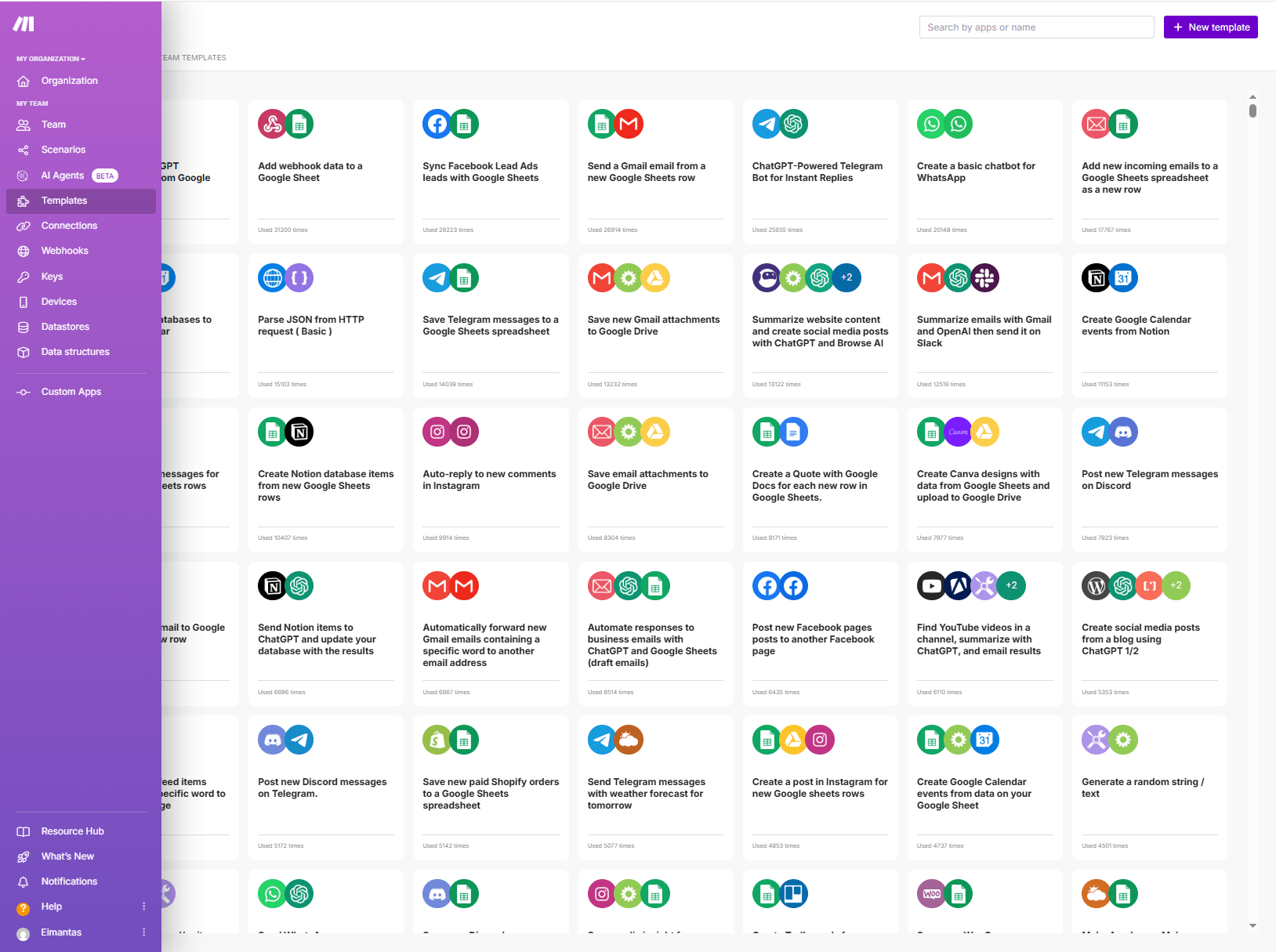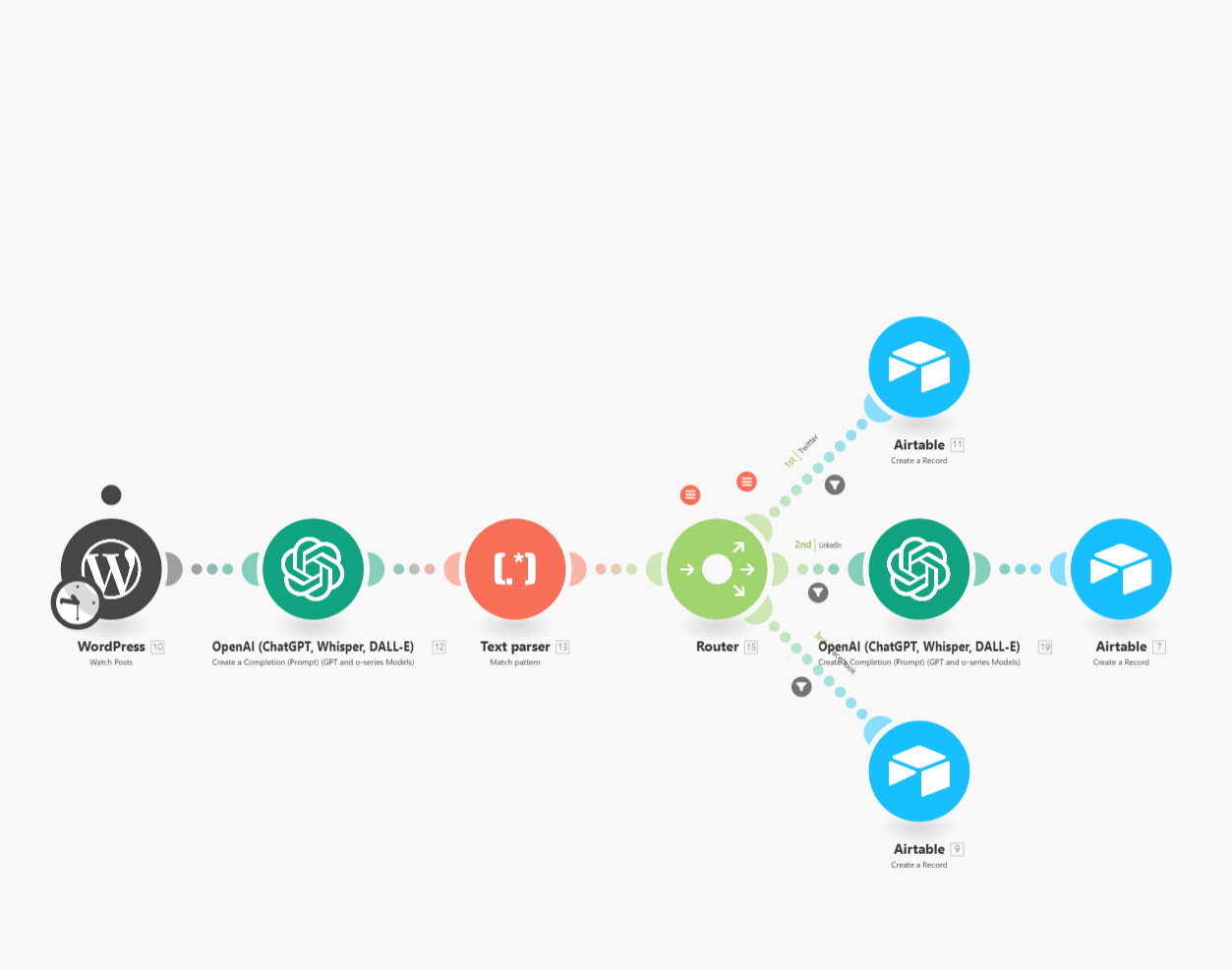Make – Visual Workflow Automation Powerhouse
Make is a visual automation platform that allows users to design, build, and automate workflows without writing code. Originally launched as Integromat in 2012, the platform was acquired by enterprise giant Celonis in 2020 for over$100 million and rebranded to Make in February 2022. This no-code tool is designed to solve the problem of disconnected apps and repetitive manual tasks that drain business productivity. It targets a wide spectrum of users, from individual freelancers and small businesses to large enterprise teams in marketing, sales, and IT.
Make’s primary value proposition is its ability to handle incredibly complex, multi-step logic in a visual, intuitive environment. It disrupts traditional automation tools by offering near-developer-level power and flexibility at a price point that is accessible to the mass market. Instead of simple, linear “if this, then that” connections, Make empowers users to build intricate, flowchart-style “scenarios” that can branch, loop, and handle errors with professional-grade sophistication, democratizing the ability to create powerful, automated business systems.
Best Use Cases
- Automation Consultants & Agencies: For professionals who build custom automation solutions for clients, Make is a superior tool. It allows them to create sophisticated, non-linear workflows with multiple decision branches and data transformations that would be difficult or impossible to build in simpler tools. For example, a consultant can build a single, elegant scenario to manage a client’s entire lead lifecycle—from initial capture and qualification to CRM entry and follow-up sequences—providing a robust and cost-effective solution.
- Marketing & Sales Operations: These teams need to automate complex lead nurturing funnels and keep data synchronized across multiple platforms. Make excels at transforming data before it moves between systems. A marketing ops manager can use it to automatically parse lead data from a webhook, reformat names and addresses, check for duplicates in the CRM, and then route the lead to the correct sales rep or email campaign based on specific criteria like company size or geographic location.
- E-commerce Managers: Managing online stores involves complex logic for order processing, inventory, and customer communication. Make can handle multi-item orders, iterate through each product to update inventory levels in real-time across Shopify and a separate warehouse system, and send conditional shipping notifications. For instance, it can be configured to send a standard notification for domestic orders but a custom email with tracking details and customs information for international shipments.
- Tech-Savvy Small Business Owners: Entrepreneurs who have outgrown basic automation tools find immense value in Make. It provides enterprise-level power without the enterprise price tag. A small business owner can use Make to connect their accounting software, CRM, and project management tool to automate invoicing, client onboarding, and task creation, creating a seamless operational backbone for their company that scales as they grow.
Exceptional Value for Money: Make’s operation-based pricing is significantly more cost-effective than the task-based models of competitors, especially for complex, multi-step workflows.
Powerful Visual Builder: The drag-and-drop canvas allows you to map out and understand your entire automation visually, making complex logic easy to follow and debug.
Advanced Workflow Logic: Native support for routers (branching logic), iterators (looping), and aggregators allows you to build sophisticated systems that go far beyond simple A-to-B connections.
Robust Error Handling: You can build custom, granular error-handling paths to make your automations more resilient, with options to retry steps, ignore errors, or trigger alternative actions.
Deep Data Manipulation: Make provides powerful built-in tools to parse, transform, and format data within your workflow without needing to write custom code.
Generous Free Tier: The free plan is remarkably capable, offering 1,000 operations per month and access to most features, allowing users to build and run meaningful automations without any cost.
Real-time Execution Monitoring: You can watch your scenarios run live, which is an invaluable feature for troubleshooting and understanding how your data flows through each step.
Each element goes as seperate line.Steep Learning Curve: While visually intuitive, mastering Make’s advanced features like data structures, functions, and error handling requires a significant time investment.
Inconsistent Customer Support: User reviews are polarized, with many reporting that customer support can be slow to respond or unhelpful, particularly for users on lower-tier plans.
Confusing Operations Model for Beginners: New users are often surprised by how many "operations" a single workflow can consume, leading to unexpected usage spikes until they learn to build efficiently.
Fewer Native Integrations Than Zapier: While its app library is growing, it does not match the sheer breadth of Zapier’s 7,000+ connections, which may be a limitation for users with niche tools.
- Visual Scenario Editor: A drag-and-drop canvas where you connect app modules to build your workflow.
- Routers: A module that splits a workflow into multiple branches, allowing you to process data down different paths based on filter conditions.
- Iterators & Aggregators: Iterators split a bundle of data into individual items to be processed one by one, while aggregators merge multiple items back into a single bundle.
- Error Handlers: The ability to define custom logic for what should happen when a module fails, such as retrying, resuming, or triggering a notification.
- Data Stores: A built-in, key-value database that allows you to store and retrieve data between scenario runs, enabling more stateful automations.
- JSON/XML Modules: Powerful tools to create, parse, and transform JSON and XML data structures, essential for working with APIs.
- Universal Connector (HTTP/API): A module that allows you to connect to virtually any web service or API, even if it doesn’t have a dedicated app on Make.
- Webhooks: Instant triggers that allow apps to send data to your Make scenarios in real-time as events happen.
- Flexible Scheduling: Run scenarios at regular intervals (down to one minute on paid plans), on specific dates, or only when triggered.
- Scenario Templates: A library of pre-built workflows to help you get started quickly with common use cases.
- Detailed Execution Logs: A complete history of every scenario run, showing the data that was processed at each step for easy auditing and debugging.
 Make also has ready to use Template library
Make also has ready to use Template library
 Modern and intuitive UX/UI
Modern and intuitive UX/UI
Frequently Asked Questions
-
What is Make primarily used for?
Make is used to automate repetitive tasks and connect different software applications, enabling data to flow between them seamlessly. It excels at building complex, multi-step workflows that require conditional logic and data transformation. -
Is Make better than Zapier?
Make is better than Zapier for complex, non-linear automations, data manipulation, and cost-effectiveness. Zapier is better for beginners, simple linear tasks, and its sheer number of app integrations. -
How does Make’s pricing work?
Make uses an “operations-based” pricing model. An operation is counted each time a module in your scenario performs an action, such as reading data or making an update. This is often more cost-effective than task-based models for complex workflows. -
Can a beginner use Make effectively?
A beginner can use Make for simple tasks by following templates. However, to use its most powerful features and build custom, complex scenarios, there is a steep learning curve that requires dedication to learn. -
What are the main limitations of Make?
The main limitations of Make are its steep learning curve for advanced features, a smaller library of native app integrations compared to Zapier, and widely reported inconsistencies in its customer support.
I’ve been navigating the workflow automation space for the better part of two decades, and I’ve seen platforms evolve from clunky developer tools to the slick, no-code powerhouses of today. My goal in reviewing Make was to determine if it truly occupies that coveted middle ground: more powerful than the entry-level players but more accessible than custom-coded solutions. After putting it through its paces, I can say it largely succeeds, but it demands that you meet it halfway.
First, I decided to build a workflow that would choke a simpler tool: a dynamic content approval process. The scenario started when a writer submitted a draft to a Google Drive folder. Make needed to grab the file, send a summary and approval link to an editor in Slack, and wait for a response. If the editor clicked “Approve,” the file would be moved to a “Published” folder. If they clicked “Reject,” it would be moved to a “Revisions” folder and a task would be created in Asana for the writer. The beauty of Make was building this entire branching logic in one visual canvas using its Router module. The flow was clear, logical, and easy to troubleshoot. Trying this in a linear tool would have been a messy, multi-part nightmare.
Next, I tested its data handling. I simulated pulling a customer list from a webhook as a JSON array. Each customer object contained a full name and an email. My goal was to split the full name into “First Name” and “Last Name” fields, capitalize the first letter of each, and then add the structured data as a new contact in HubSpot. Make’s built-in text parsing functions and data mapping interface handled this flawlessly. This level of data transformation is a core strength and a key differentiator from competitors who would force you into a paid, code-based step to achieve the same result.
The pricing model is where Make truly shines. The two scenarios I built would have rapidly consumed “tasks” in a competitor’s plan, but they were a mere handful of “operations” in Make. For any business looking to scale its automations, the cost savings are not just marginal; they are substantial.
However, this power is not without its price—and I don’t mean money. The learning curve is real. While I could build my test cases, I had to reference documentation to understand how Make handles data arrays and mapping. A true beginner would be lost without dedicating a few hours to tutorials. You have to think like a developer, even if you aren’t writing code.
Top Alternatives to Make
-
Zapier: Zapier is the undisputed king of simplicity and connectivity, boasting over 7,000 app integrations. Its linear, step-by-step editor is perfect for beginners who need to set up simple “if this, then that” workflows quickly. Choose Zapier when your primary need is to connect a niche application or when your automation tasks do not require complex logic. Its main weakness is its task-based pricing, which becomes prohibitively expensive for multi-step automations.
-
n8n: As an open-source platform, n8n offers unparalleled flexibility and control, especially for developers. It can be self-hosted, which is a major advantage for data privacy and cost savings. Choose n8n if you have the technical expertise to manage your own instance and need to build highly customized or proprietary integrations. Its primary drawback is that it requires technical knowledge for setup and maintenance, making it unsuitable for non-technical users.
-
Workato: Workato is an enterprise-grade integration platform as a service (iPaaS) built for large organizations. It offers robust security, governance, and the ability to handle mission-critical, high-volume processes. Choose Workato if you are a large enterprise with a dedicated IT team, complex integration needs, and a significant budget. It is not designed or priced for small businesses or individual users.
Final Thoughts
Make has carved out a brilliant and essential niche in the automation market. It is the definitive “power-user” tool, delivering the functionality of a developer’s toolkit in a visual, no-code wrapper. It’s the logical next step for anyone who feels constrained by the simplicity and cost of other platforms.
My verdict is clear: If your automation needs are simple A-to-B connections, stick with a more basic tool. But if you aspire to build true, automated systems that can think, branch, and handle complexity, Make is the most powerful and cost-effective choice on the market, provided you’re willing to invest the time to learn it.

